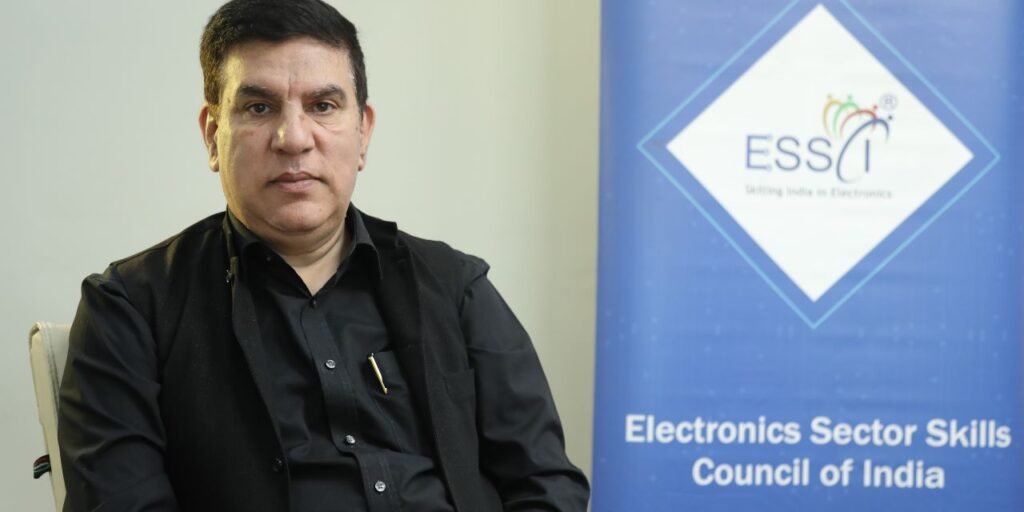By Mr. Saleem Ahmed, Officiating Head, ESSCI

Aligning this expansion with sustainable practices has become essential as India takes significant strides to become a worldwide centre for semiconductor manufacture. India is rapidly becoming into a major global centre for the production of semiconductors. By 2023, India’s rising skills in the semiconductor industry are reflected in its 39th-place ranking in the world. With the goal of gaining at least 10% of the worldwide semiconductor industry by 2030, the nation has big ambitions to increase its footprint. Although crucial to scientific progress, semiconductor production is resource-intensive, resulting in high energy and water use, waste, and pollution. India must address these environmental effects if it is to keep its economic advantage and meet its lofty sustainability targets.
India’s Environmental Challenges and Semiconductor Push
Manufacturing semiconductors uses a lot of energy and water; each year, fabs use millions of metric tonnes of water and a lot of electricity. India wants to raise
If sustainable methods are not adopted, the environmental effect of domestic semiconductor manufacture will increase. Recognizing these challenges, the Indian government has established the India Semiconductor Mission (ISM), with an allocation of ₹76,000 crore (over $10 billion USD) to support semiconductor manufacturing, display fabs, and compound semiconductors, among others. This mission prioritizes creating high-tech clusters with infrastructure for energy and water conservation, aiming to balance economic growth with environmental stewardship.
Methods for India’s Sustainable Semiconductor Production
- Integration of Renewable Energy and Energy Efficiency: Where practical, Indian factories are switching to renewable energy sources and implementing energy-efficient technology.This is consistent with the nation’s goals for renewable energy, which include reaching 500 GW of renewable capacity by 2030. Given the burden that industrial expansion and climate change are placing on India’s electrical infrastructure, it is imperative that solar panels, microgrids, and energy-efficient lighting be integrated into factories. The shift to sustainable energy sources is also being aided by cooperative initiatives with technology and electricity suppliers.
- Water Conservation and Recycling: Effective water management has become a top concern due to the high water requirements for semiconductor fabs. Up to 75% of the water used by advanced factories is treated and reused through recycling technologies. In water Such steps are necessary to continue operations and prevent the depletion of local water supplies in limited locations, especially in states like Karnataka and Maharashtra where semiconductor production is growing.
- Cutting Carbon Emissions with Cutting-Edge Technology: Factories are investing in process-gas abatement technologies and less environmentally harmful substitute materials as they strive for fewer emissions. Consistent with India’s Fabs are progressively putting modern air and chemical filtration systems into place as part of their commitment to lowering greenhouse gas emissions. India’s commitments to the Paris Agreement, which call for a reduction in industrial emissions, are in line with the shift towards greener technology in factories.
- worker and Supply Chain Development: India is making great strides in developing a semiconductor ecosystem that prioritises domestic sourcing, lessens reliance on imports, and enhances worker competencies. The To promote the local manufacturing of semiconductor components, the government has launched a number of programs, such as the Production-Linked Incentive (PLI) scheme. This program is a component of India’s larger effort to build a more robust supply chain that reduces transportation-related emissions while simultaneously addressing interruptions.
In parallel, industry, academia, and governmental organisations are working together to assist initiatives to develop a competent workforce. The Electronics Sector Skills Council of India (ESSCI) and other organisations are essential to training employees in semiconductor manufacturing technology in order to address the skills gap. In the upcoming years, this will guarantee that India has the people resources needed to fulfil the rising demand for semiconductors.
- Circular Economy Initiatives and E-Waste Management: In keeping with sustainable growth, India is also concentrating on e-waste management in the semiconductor sector and Circular Economy practices. The government has started measures to promote the recycling of semiconductor components and other electronic debris, like as the National E-debris Management Policy and other state-level e-waste collecting programs. By encouraging the appropriate disposal and recycling of semiconductor materials, these regulations seek to lessen the environmental impact of the industry.
Furthermore, the Ministry of Electronics and Information Technology (MeitY) has included the concepts of the circular economy into its development plans, advocating for systems that recycle, reuse, or repair materials, which would further support India’s goal of encouraging sustainability and lowering dependency on imports.
It is anticipated that the emphasis on developing a circular semiconductor ecosystem would lead to employment creation in the recycling and waste management industries, supporting India’s environmental and economic objectives.
Prospects for Long-Term, Sustainable Development in Semiconductor Manufacturing
India’s sustainability-focused programs, such the PLI and ISM schemes, are essential to fostering a robust and environmentally responsible semiconductor sector. By setting up high-tech India is putting itself in a position to compete in the global semiconductor industry while furthering environmental goals by fostering clusters and sustainable practices. The continued adoption of energy-saving technologies, water management practices, and circular economy principles will be essential as India scales its semiconductor capabilities. Through these efforts, India aims to make semiconductor manufacturing both a driver of economic growth and a model of sustainability.
India’s commitment to environmentally friendly semiconductor manufacturing demonstrates its commitment to attaining economic progress, technical independence, and environmental sustainability, laying the groundwork for an ethical and competitive sector. In summary, sustainability in semiconductor production is now a strategic need rather than a choice. As India’s semiconductor industry grows, incorporating sustainable procedures will guarantee that development is in line with environmental stewardship. In addition to helping the economy, this will support the achievement of challenging environmental targets. According to
recent estimates, India’s semiconductor market is projected to grow from $15 billion in 2020 to over $64 billion by 2026, underscoring the need for responsible growth. Initiatives such as the Production-Linked Incentive (PLI) scheme and circular economy policies are vital in minimizing the sector’s environmental footprint, ensuring that this growth remains sustainable in the long term.
